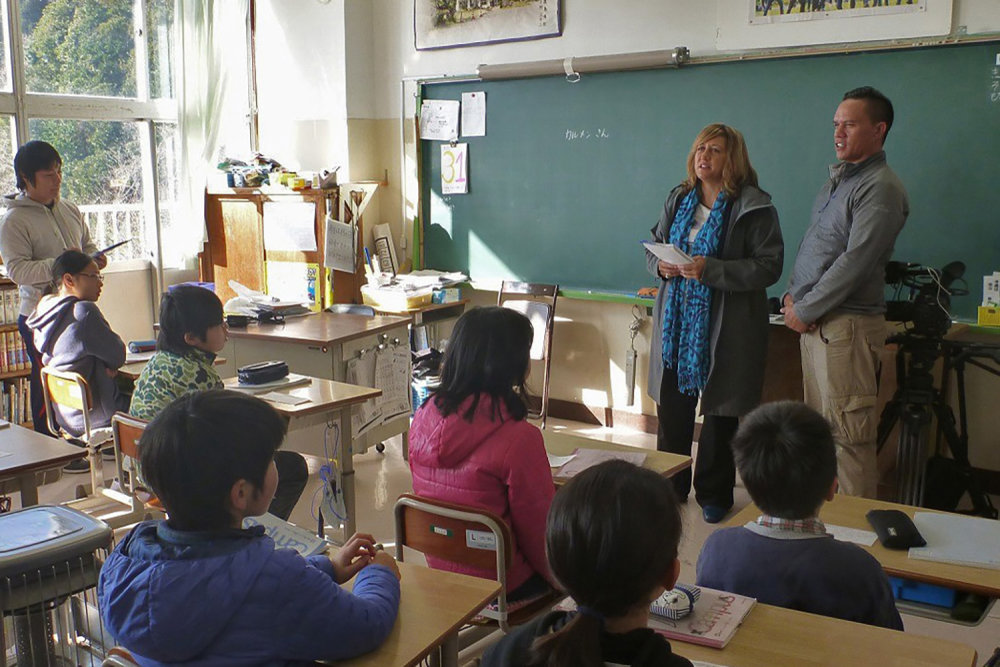
Carmen Parahi and cameraman Phillip Davis singing a waiata to school children
Two months after our Asia New Zealand Foundation-funded trip to Japan, I feel a little homesick. I miss the people, sounds, smells and food of Japan. It’s a strange statement to make because cameraman Phillip Davis and I only spent one week in Japan; yet, I feel nostalgic as if I must return there one day, soon.
Our programme was organised by the Foreign Press Center of Japan (FPCJ), whose staff helped us to get stories on New Zealand-Japan rugby links, Māori-Japan connections, and whaling. We started filming on the day we arrived in Tokyo and didn’t stop filming until the day we left.
Mayuko Fukusawa came to our hotel on the day we arrived, met and escorted us through the excellent but daunting Tokyo train system to the Foreign Press Center office. From there, we went to our first shoot.
The Center helped provide interpreters for every interview that was not in English. In all, we had four different interpreters and they were invaluable.
It was my first trip to Japan and I was impressed by the number of Japanese people who spoke English, although we tried to speak as much basic Japanese as we could. I enjoyed the custom of bowing and it didn’t take long before it became a natural act. I had made up business cards urgently before I left. I used them all as I went through the card exchange custom every time I met someone.
During the week, we joined other media on a two-day, Foreign Press Center-organised jaunt to the Oita prefecture, about 800km south of Tokyo. We had our own tailor-made visit to a town called Beppu, a sister-city to Rotorua, which is famous for its natural geo-thermal features. It was a real pleasure visiting and finding out there is a strong connection to Māori.
We were escorted by a large number of officials and were interviewed by a local news crew during the Beppu trip. Phil was able to connect with one of our talent, a Japanese man who was good friends with Phil’s uncle from Rotorua. Phil’s uncle’s photos were on the wall in the office we were filming in. Small world.
The next day we visited Oita’s specialist food companies in the countryside. We learned about the processes to create each product from shiitake mushrooms, to flounder and horse mackerel. It’s very labour-intensive, very impressive. But the traditional methods were dying out, along with the ageing workers.
I also managed to try an onsen, a traditional public bath in Oita city. What a wonderful experience. I knew there were rituals and expectations about using an onsen and although I was nervous I had to give it a go. I’m glad I did.
Near the end of the week we travelled to Minamiboso, a whaling region. The doors were wide open for us. This was surprising and welcomed as we knew Japan’s whaling communities were suspicious of western media. Everyone we spoke to was honest and upfront about what they do.
We went inside a whaling station, whale meat factory, visited a local school and museum. We were also given whale meat to eat. I found it very difficult personally but culturally did not want to offend our hosts. I believe we were able to gain so much trust because we were a Māori programme interested in the traditions of whaling.
The classroom we visited asked us to talk with them before we started filming. Phil and I did a mihi in te reo Māori, sang a waiata and performed a haka. We could see they enjoyed this. Interestingly, most of the question time was spent asking Phil about his moko kirituhi, Māori designs tattooed on his forearm.
In seven days, we filmed five Māori focused current affairs stories for our TV One programme, Marae with an average eight-minute duration for each story.
Prior to leaving for Japan, I had spent many hours and sent hundreds of emails trying to organise stories. Without the help of the Asia New Zealand Foundation and Mayuko Fukusawa of the Foreign Press Center of Japan (FPCJ), we would not have been able to do as much as we did.


